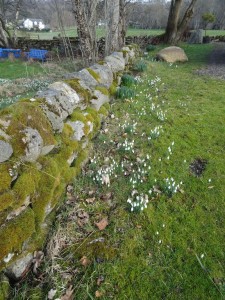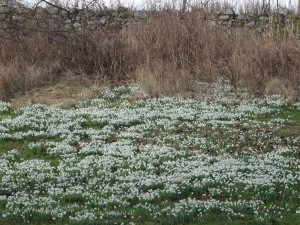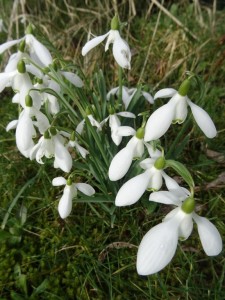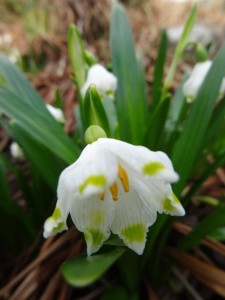Looking out of the window as I write, I see that this Spring – if this is indeed Spring for the weather continues to jump about, back and forth, provocatively, in teasing fashion – the snowdrops have doubled in size, as in covering twice as much ground as last year.
They like us being here, I think.
They know we are acting as guardians rather than owners. They rejoice in our energy and admiration. They feel safe enough to multiply and offer passers by, on the A923, a marvelous display. Just yesterday, two cyclists shouted their appreciation: “Oh wow, look at that. What a garden!”
Looking, and seeing. There is a difference for sure.

The road runs from left to right, right to left, over the wall between the blue furniture at the entrance to the labyrinth, and The Bonnet, a neighbour’s house in the distance…
The young women looked quickly, glanced, and then moved on. They did not stop to see… to take time to dismount, wander around, breathe in the quiet sappy fragrance, and look deeply into the heart of the flowers… into their spiritual core, their essence of being.
It is the same with all of us. Even when living closely with someone, do we really see them? That is why the phrase, “I see you” resonated with so many in the film Avatar. Quite often Akii and I will stop, gaze deeply into one another’s eyes, and say the words: I see you. We always feel so much closer afterwards.
This “seeing” is a re-connecting on a spiritual level. It is the recognition that we are spiritual beings enjoying a human experience, rather than the other way around. Those who look go no further than enjoying the human experience, so missing the point of existence. They are too busy rushing from point A to point B, focused on the destination rather than the journey.
So let me focus, just for a while, on the snowdrop, regarded by so many as the harbinger of Spring. When it snowed the other day, they disappeared, were invisible; when the snow melted, they reappeared again, quite unscathed. Unlike many buds on trees and shrubs that yet again seem to have gone into shock at such swift climatic changes. Delicate the snowdrop may appear, but hardy is its second name.
Known since the earliest of times, the snowdrop was named Galanthus (from the Greek for ‘milk flower’) in 1753. Nowadays there are twenty recognised species of this bulbous perennial in the family Amaryllidaceae, ranging in shape, colour, design, height and size. (My aunt, who knew the Latin names of all the plants and shrubs and trees she planted in her garden, would be so proud that I have got around to learning this.) In the northern hemisphere, which is where we are, snowdrops have usually finished flowering by the vernal equinox on March 20 or 21. So carrying us neatly into Summer.
Snowdrops are also known as Candlemass Bells. Candlemass was originally an ancient festival (rather than pagan, which I regard as rudely ignorant) that marked the middle of winter – this year, February 2. Later it was given a Christian perspective:“The snowdrop, in purest white array/First rears its head on Candlemass Day.”
Because they are one of the earliest plants to flower, snowdrops have not only become symbols of Spring, but taken on some weird and wonderful associations, linked to what pragmatic opinion now consider to be Old Wives’ Tales.
The most common is that it’s unlucky to bring snowdrops into the house. This superstition, which appears especially strong in the West of England, and on the Isle of Mull, seems to hark back to Victorian times, when the snowdrop became associated with death, and therefore a bad omen. (They were a gloomy lot at the best of times, the Victorians!)
Legends also abound throughout Europe, the most well known – and most positive, apart from Woman being made to suffer rather more than Man! – being its association with the biblical Garden of Eden:
Adam and Eve were kicked out of the Garden of Eden, a place where the sun shone every day, where they were warm and happy and had everything they could possibly wish for or want. Unfortunately for them it was winter when they landed on earth, heavy rain, cold winds and dark grey skies. Eve spent every moment shivering, something she had never experienced before; she never needed to wear clothes, she didn’t even know what clothes were. It was so cold that she felt as if her blood was beginning to freeze, and then the snow began to fall.
At first the snow looked so pretty but that soon wore off; the blizzards made her eyes sting, her face hurt, her fingers were going numb and her body began to freeze. Eve fell into a deep despair: would this cold never end, would she ever feel the warmth of the sun upon her face, would she ever feel warm again? She fell to her knees and began to cry.
God hadn’t abandoned Adam and Eve completely; he had sent an angel to watch over them. Upon seeing Eve kneeling in the snow in a state of deep despair sobbing her eyes out, the angel asked her why she was so sad. Eve told the angel that she despaired of ever feeling warm again; she had given up hope of ever seeing the sun, of ever being happy.
The angel reached down and picked up a snowflake, gently she breathed on it, and let it fall back to the frozen ground. Every time she did this the snowflake turned into a small flower as white as the snow upon which it fell until Eve was surrounded by a carpet of small pure white flowers.
“Why have you done this for me?” asked Eve,
The angel replied: “To show you that winter will end, that flowers will bloom again and the sun will shine. This gift I give you is the gift of Hope”.
The flowers that the angel created became known as Snowdrops and they give us hope of a new spring, a new beginning, and new life.
Thanks to Silent Owl of County Mayo for this: http://amayodruid.blogspot.co.uk/2013/02/thelegend-of-snowdrop.html
Most interesting of all, to me at least, the name of the flower does not mean a drop of snow, but derives from ‘ear drop’, the old word for earring.
Interesting to me because having learned rather more than I knew a couple of hours ago, I can now more honestly say, I see.
And ‘seeing is believing’… an idiom first published in a collection of Proverbs in English and Latin by John Clarke in London in 1639. It means, of course, that concrete or physical evidence is convincing.
Or is it? I love earrings, and wear four, two in each ear, all of which are different. Why? The simple reason is that I lose them, one at a time. Often this is while I’m gardening. I come back to the house and realize… oh no, another one gone.
So the thought bubbles up, that they are simply manifesting as flowers; which is why the land is awash in ear drops.






